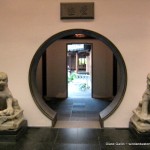March Madness

Have you noticed how quickly time is passing? I know it has more to do with the activity around us than the actual passage of time, but life seems to be moving along at quite a pace. Faster technology, “breaking” news (newsworthy or not) and multitasking are the new norm. Even social media experts advise clipping the words and phrases we use, since attention spans are not what they used to be. Work follows us from the office to the airport and home again via laptops and smart phones. We never miss a call from a loved one or important message from a client. And Daylight Saving Time arrives in March now to help increase our productivity. But all this activity doesn’t leave much time for contemplation.
The natural world cycles energy (ch’i) differently than man-made energy, ebbing and flowing throughout the day in measured sequence. No matter how hard we try manipulating it, nature moves at its own pace. Witness the sun easing into the sky each morning, behaving as though it needs coaxing. Overhead at noon, it gets to work eliminating shadows and illuminating our work, growth and play. At day’s end the sun slowly falls from the sky, blanketing earth with darkness, preparing us to settle down, rest and heal. Plants and animals obey the rules and retire for the day, but we humans have so much more to do.

Both western and traditional Chinese medicine acknowledge that emotional stress in a person’s life contributes to “dis-ease” and physical illness. Too much stimulation causes anxiety and the eventual breakdown of immunological defenses. Feng shui teaches that design details in our buildings impact every aspect of our lives – for better or worse. Too much or too little energy (whether natural or man-made), an imbalance of elements or disruption in the flow of ch’i creates instability, so balancing the yin and yang of a space is important. For example, electronic equipment, bright primary colors and dramatic artwork stimulate conversation in gathering spaces, but interfere with rest in the bedroom and concentration in the study. Images of nature, soft music and pastel colors promote healing and calm anxiety in medical buildings but won’t motivate the staff in sales and marketing.

If stress, responsibilities and lack of available time block the path to relaxation, how can we slow it all down? An important feature of the classical Chinese garden is the entrance. The gate is purposely made smaller so that you must slow down to enter. Like a labyrinth, you are required to walk through in single file and contemplate the reason for your visit. The Chinese garden follows the measured pace of nature and is not hurried or distracting. It’s a portal to another time and place where mindfulness replaces the to-do list, and you leave feeling a bit more relaxed than you did when you entered.
Take the energetic pulse of your typical day this week and try to measure the balance of yin and yang energy around you. You will find that burdens feel lighter after changing just a few things in your home and work environment, whether it’s clearing clutter or turning down the light, color or noise levels. Then head outside, even for brief minutes at first, to spend time in the natural world where the clock has no authority. Give yourself the gift of mindfulness and all the benefits it has to offer.
Wishing you the luxury of time and good ch’i,
Diane Gallin, CFSC
![]()
